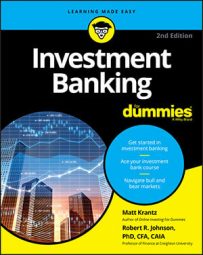IPOs are a financial transaction that requires the heavy involvement of investment banks.
In this article, you find out the basics of IPOs. In a traditional IPO, the investment banking operation gets involved very early. The investment bankers are critical partners in allowing a company to go public.
 ©By vchal/Shutterstock.com
©By vchal/Shutterstock.comThe lifecycle of a company: When going public makes sense
When a company is young, financing can get pretty dicey. It’s not unheard of for very early investors to pay for equipment and salaries of employees with any money they can get their hands on. Charging up credit cards, hitting up family members for loans, and tapping retirement savings are all ways that an entrepreneur with the burning passion to start a company gets the process started. Starting a company takes a tremendous amount of money.If the company proves to be successful, the options for raising money, or financing, grows. Prior to going public with an IPO, a growing company may consider a few options to raise money, including the following:
- Venture capitalists: Venture capitalists are investors who pool money from other investors looking for very high potential returns, and are willing to suffer huge losses in the process. Venture capitalists take the money they gather, usually from large institutions like insurance companies or pension funds, and bet money by buying stakes of young companies that have great prospects. Although many of these bets don’t pan out, if the venture capitalists hit it big with a few of their bets, the returns can be huge. You don’t need to invest in many Googles (which ultimately sold stock to the public in a huge payday for venture capitalists) to make the gambles worthwhile.
Although venture capitalists can be a critical place for young companies to raise money, it comes at a steep price if the company pans out. The venture capitalists end up owning a big slice of the company, which reduces the ultimate payout for the entrepreneur.
- Bank loans: Commercial banks are in the business of lending to companies that need capital. Periodically, a bank may extend a line of credit to a small business, especially if the business is stable. Banks, though, tend to be skittish and won’t lend if there’s even a scent of risk with the company. Internet companies, which have little in the form of assets, for instance may be turned away for bank loans because there isn’t anything to be used as collateral.
- Crowdfunding: The idea of crowdfunding is very new but likely to become more important. Currently, an entrepreneur with an idea can use websites like Kickstarter to explain to the public what her idea is and how much money she needs to make it happen. Consumers interested in making the product come to life are able to pledge a dollar amount on the crowdfunding site. As soon as enough money is raised, the company can use the cash to build the product.
Crowdfunding is currently only a way for consumers to donate money to new businesses, not invest in them. Typically, these crowdfunding donors are given a token of appreciation for their contributions, usually early dibs on the product after it’s released. Currently, though, companies aren’t allowed to sell stock using crowdfunding. That’s changing though. The 2012 Jobs Act contains a provision that opens the future to the idea of stock-based crowdfunding where companies can sell stock to the public. The SEC is tasked with the job of allowing companies to raise money with crowdfunding, while protecting investors.
For much more information on crowdfunding, check out Crowdfund Investing For Dummies, by Sherwood Neiss, Jason W. Best, and Zak Cassady-Dorion (Wiley).There may be options for companies not ready for an IPO to raise money. But at some point, the companies with the best prospects outgrow the venture capitalists, don’t want to pay the onerous terms of bank loans, or need more capital than can be raised casually. When these things happen, it’s time for the company to go public. Going public is a relatively long and costly process that requires preparing statements for regulators and investors, getting the company’s story out, and actually selling the shares.
IPOs tend to be lagging indicators, meaning investors are more willing to take a wager on a newly public company when the broader stock market is doing well. IPOs tend to ebb and flow quite a bit, as the table shows.
| Year | Number of U.S. IPOs | Proceeds Raised |
| 2018 | 192 | $46.9 billion |
| 2017 | 160 | $35.5 billion |
| 2016 | 105 | $18.8 billion |
| 2015 | 170 | $30 billion |
| 2014 | 275 | $85.3 billion |
The role of the investment banker in IPOs
Investment bankers are involved in the very onset of a company going public, and they’re the keys to making the deal happen. When investment bankers assume the role of selling securities, especially in an IPO, they’re often called the underwriters.A typical IPO usually follows these steps:
- The company produces information about its stock sale. The company must give investors an extremely detailed outline of its opportunities, financial results, and risks. This filing is called the prospectus. Investment bankers assist in making sure the company includes all the material information investors need to know about the offering.
- The company takes its story to the streets. If companies are going to ask investors to pony up millions of dollars for the company, they’re going to have to convince them to buy. That’s the role of the roadshow. Roadshows are events and meetings investment bankers arrange between companies selling stock and prospective investors.
- The investment bankers gather up the investors in the book-building process. The traditional IPO is a process shrouded in a bit of secrecy. During the roadshows, investment bankers get an idea of how likely it is for specific investors to buy stock, how many shares, and at what price. The investment bankers record this indicated interest, or general idea of how much buyers want to invest, to gauge how many shares are likely to be bought when the IPO is sold. This process of tallying up how much interest there is in the stock is called book building. The book-building process is critical because it tells the investment banks selling the deal at what price the shares should be sold.
- Underwriters price the deal. Underwriters typically work late into the night before the stock starts to trade, assembling all the orders of investors. The underwriters look at all the orders for the stock and at what prices investors are interested. The underwriters then find the highest possible price at which all the shares would sell. The IPO is priced, or the initial price charged to these initial investors is set.
- Underwriters support the IPO. The initial price of the new stock is set by the investment bankers the night before, and all the shares are sold to the initial investors. The initial investors in IPOs are typically the friends and business partners of the underwriting firms. For instance, large institutions that use the investment bank’s other services are often given access to IPOs, as are wealthy individuals that may be clients of the investment banks.
After the deal is priced, these initial investors are free to sell on the open market, in what’s called aftermarket trading. And it’s during the first day of regular trading when regular investors, customers of brokerages like TD Ameritrade and Charles Schwab of the world, are able to buy the stock.
What matters in an IPO
Underwriters stay involved in the process during this tenuous first day of trading. Investment banks want to do whatever they can to make sure the shares of the newly public company don’t break (close below the initial price). A broken deal is often looked at negatively by investors; plus, a broken deal makes it look like the investment bank didn’t set the initial price correctly.Investment bankers try to balance the needs and wants of the buyers and sellers. If the price of the IPO zooms upward, the investors who sold their shares may feel like they were shortchanged and missed out on gains. However, if the price drops after the stock starts trading, the buyers may feel cheated and avoid that investment banking firm’s deal in the future. There’s also a risk that if an investment bank prices shares too high, it might need to step in and buy the shares to stop them from falling too much. On the first day of trading of Internet stock Facebook in May 2012, for instance, underwriters had to step up and buy to hold the stock from closing below the $38-per-share offering price.
Lastly, several months after the IPO has been trading, the investment bank’s research unit will initiate coverage on the new stock. A research analyst at the bank will write a report describing the company and the stocks, advising the investment bank’s clients on whether to invest in the new stock.

